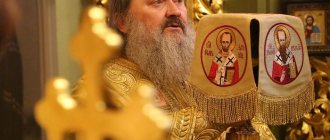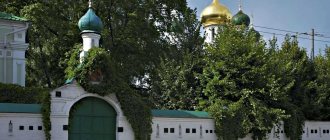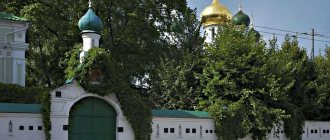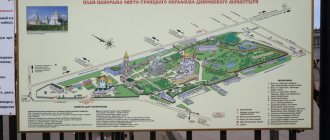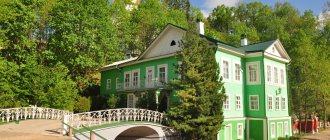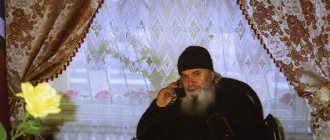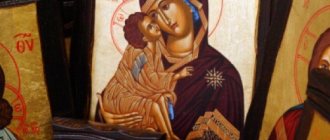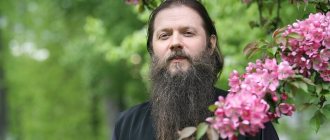"Save me, God!".
Thank you for visiting our website, before you start studying the information, please subscribe to our Orthodox community on Instagram, Lord, Save and Preserve † - https://www.instagram.com/spasi.gospodi/. The community has more than 60,000 subscribers. There are many of us like-minded people and we are growing quickly, we post prayers, sayings of saints, prayer requests, and timely post useful information about holidays and Orthodox events... Subscribe. Guardian Angel to you!
In the Holy Dormition Pskovo-Pechersky Monastery, one of the most famous churches in the world, there is a huge monastery with a centuries-old history, the basis of which was the elders - the great righteous people of their time. The monastery was never closed during its entire long life; it was not broken by wars and persecution by the authorities. It is rightfully considered a masterpiece of Christian culture, for it combines the unshakable beauty and majestic spirituality of Orthodoxy.
Caves of the Pskov-Pechersky Monastery
The very name of the monastery is directly related to the caves that are located in it. The year 1473 was marked by the consecration of the cave church of the Assumption, which was dug out of sandstone in a hill by the Monk Jonah. The same year, according to legend, is the date of foundation of the monastery, and the hill in which the church and caves are located is called the Holy Mountain.
The complex of monastery caves consists of near and far:
- the nearby ones are about 15 m long. They also contain tombs with the relics of the great saints;
- distant - consist of 7 underground gallery-streets with a length of about 200 m, which is adjacent to the cave Church of the Resurrection of Christ (end of 6th street). These caves are also the cemetery of the monastery. The remains of the most famous people of Orthodox culture are buried there.
The best article for you, go to: “Peschanskaya” icon of the Mother of God in what helps
So there are certain burial rules:
- monastery monks - on 5th and 6th streets;
- laymen - on others.
They are buried in coffins that are placed in the walls of caves and are not covered with earth. The total number of burials fluctuates around ten thousand people.
Saints of the Pskov-Pechersk Monastery
The great history of the monastery resulted in its no less great legacy, for only thanks to this was it able to preserve the ancient monastic traditions and combine them with the flower of the world eldership.
At the end of the 20th century, the now canonized saints carried out their activities there:
- Metropolitan Benjamin;
- Hieroschemamonk Simeon;
- Archimandrites John and Alypius;
- schema-abbot Savva;
- Hieroschemamonk Michael;
- Valaam elders and other ascetics of God's Word.
Also in the temple are the greatest shrines of the Orthodox religion, known throughout the world:
- the relics of Saints Mark, Jonah, Vassa, Cornelius, Lazarus, Simeon and the martyr Tatiana;
- icons of the Mother of God “Assumption of the Blessed Virgin Mary” and “Tenderness”, icon of St. Nicholas the Wonderworker.
Elders of the Pskov-Pechersk Monastery
The monastery has always attracted pilgrims from all over the world. Some were traveling to see great shrines, and many were traveling for the advice of wise elders.
One of them was Lazarus the Farsighted, who rose from the grave on the third day after death and lived for another 16 years, repeating: “The death of sinners is cruel.” One day, Emperor Alexander I wished to meet with him, and the elder spoke to him about the need to serve as an example for his subjects, because the life of any person on earth is short.
The canonized Venerable Simeon was a particularly revered elder of the temple. He was known for his miraculous abilities to heal the body and soul of a person, even to delay the arrival of death.
Also, the Elder Confessor John has always been held in high esteem by Orthodox people. During his lifetime, people from different countries came to him for consolation and wise advice.
The best article for you, go to: Saint Cyril Equal to the Apostles
The most famous elders of the Pskov-Pechersky Monastery today are:
- Archimandrite Tikhon;
- Schema-Archimandrite Nikon.
Tikhon has been in the Pskov-Pechersk Monastery since 1995. Having come from a family of clergy, he also dedicated his entire life to this noble and righteous cause. His path to the Lord was filled with humility and repentance in deeds:
- representative of the temple brethren;
- monk;
- hierodeacon;
- hieromonk;
- assistant cellarer and dean;
- graduate of Theological Seminary;
- teacher of theological school;
- abbot of the monastery;
- graduate of the Theological Academy with a candidate's degree in theology.
His deeds throughout his spiritual formation were distinguished by their righteousness and piety, and his contribution to the development of Orthodox culture cannot be overestimated. And yet, his main field of activity remains people who need his help and support. Thousands of parishioners come to the elder every day for wise words in order to find long-awaited peace and humility.
Elder Nikon. Today it also occupies a very important place in the Pskov-Pechersky Monastery. His road of life was no less thorny, but the Lord was always next to him, who showed him his true destiny.
Nikon's actions have always been aimed at the spiritual education of the Orthodox people: with his sermons he tries to heal souls and guide people along the righteous path. The divine services that he conducts and in which he takes part are beautiful and spiritually rich events, the purpose of which is to make a person himself realize, understand and accept God in his soul.
The elders of the Pskov-Pechersky Monastery are truly great people of the past and present, because in their words there is faith and truth, and in their deeds there is kindness and grace. They are the stronghold of the Orthodox religion, and their significance for its further development is enormous.
The best article for you, go to: Hieromartyr Polycarp Bishop of Smyrna
Academy of Pechora Elders
A new issue of the Monastic Bulletin magazine has been published - No. 2 for 2017. Its theme is abbot, father, mentor, confessor. With the kind permission of the editors, we publish one of the articles in the issue - about the Pskov-Pechersk Monastery.
It turns out that sometimes it is more convenient to see the heavenly world from the depths of a cave. Surrounded by dozens of buried ascetics and simple lay people, whose bodies do not exude the smell of decay - and the air around is clean and fresh - in the pleasant coolness, in the darkness of the dungeon, the thought that he is dust and to dust will return somehow naturally comes to a person. In the caves of the Pskov-Pechersky Monastery, the mind becomes clearer, the gaze is deeper, the heart is calmer.
The Holy Dormition Pskovo-Pechersky Monastery is unique in that it has never been closed. The tradition of monasticism and eldership was not forcibly interrupted here during the years of Soviet atheism, as tragically happened with almost all monasteries of the Russian Church. The spirit of the monastery, its way of life, the relationship of the governor with the brethren, communication between the inhabitants - all this is a precious treasure that God, in His special Thought, preserved here, in the small town of Pechory, on the very western border of Russia.
Thousands of pilgrims flock here for this untouched treasure. They come not only from the east, that is, from almost the entire rest of Russia, but also from all places of canonical responsibility of the Moscow Patriarchate. There are many pilgrims and tourists in Pechory from the western side - from the Baltic states, which are just a stone's throw away, and from all of Europe.
The Pskov-Pechersky Monastery is located at the junction of state borders and the borders of civilizations. This position seems to emphasize his unearthly citizenship, the sublimity of the mountain . There is no continental strength of the Urals and Siberia here, the winds of Europe come from the Baltic Sea, so you don’t believe the earthly in Pechory, you can only grow your roots into the heavenly. This is what the ascetics of these places did for more than half a thousand years.
However, the roots also go deep into the earth - but this direction was not chosen by people, but by God. Because the local caves are “created by God,” that is, given by the Lord himself from above. And in the caves it is more reliable, more thorough than on the plains of the main road from East to West and back.
The deep, unshakable silence of these cave “streets”, not disturbed even by dozens of pilgrims walking on the sand, their constant “microclimate” - in winter and summer the same temperature, the same humidity - seem to again testify: there is changeable, transitory in life, and there is Eternity.
"Strong Point"
The history of the monastery begins in 1473, with the consecration of the Assumption Church by St. Jonah, dug into a sandy hill near the Kamenets stream. This stream has survived to this day and flows right under the bulk of the monastery.
However, even before this moment, significant events took place at the holy place. Thus, according to the chronicle, at the end of the 14th century, Izborsk hunters - father and son Selisha - heard “the voices of those singing ineffably and beautifully” near the Kamenets stream, and also felt a fragrance similar to incense. Soon, local peasant Ivan Dementyev, who acquired these lands by lot, was cutting down forest on the mountainside. Under the roots of one of the fallen trees, an entrance to a cave opened, and above the entrance there was an inscription: “Caves created by God.”
In these places lived people from the Kiev-Pechersk Monastery, who moved to the Pskov lands in search of refuge from the frequent raids of the Crimean Tatars. Only the name of the initial monk, St. Mark, has been preserved.
The future Reverend Jonah himself was, before his tonsure, a priest in the St. George Church of St. George of Livonia (the present city of Tartu), named John, nicknamed Shestnik, that is, a stranger, because he came to Livonia from Moscow on a mission.
Together with his family - his wife Maria and children - Father John moves to Pskov, escaping German-Latin persecution. Having learned about the wonderful caves, they settle in their surroundings. Seriously ill, Maria decides to take monastic vows - so nun Vassa becomes the first resident of the monastery. Her husband soon followed her example.
And then a miracle happened: fire coming from the altar of the temple expelled the invaders from the monastery
Jonah's successor, Hieromonk Misail, built cells and a temple on the mountain, but the invading Livonians burned the wooden buildings and plundered all valuables. However, a miracle happened here: fire emanating from the altar of the temple expelled the invaders from the monastery.
Raids occurred regularly: the monastery was perceived not so much as a place of monastic exploits, but as a stronghold of Russian influence in the region.
The flourishing of the monastery is associated with the abbot, the Venerable Martyr Cornelius. In 1541, he built the refectory Church of the Annunciation, expanded the Assumption Cathedral, and dug further monastery caves. In just seven years - from 1558 to 1565 - stone walls were erected around the monastery, which was a rarity in those days. In 1570, Tsar Ivan the Terrible visited the monastery-fortress. Seized by the “mania of omnipresent treason,” he did not accept the abbot’s greeting and, according to legend, right there, at the gates of the monastery, he accused Cornelius of high treason (in particular, of harboring the fugitive prince Andrei Kurbsky) and carried out the death sentence. True, as often happened, the tsar at that very moment repented and carried the body of the murdered abbot to the Assumption Cathedral. Since that day, the path from the gateway St. Nicholas Church to the Assumption Church has been called the “Bloody Path”.
The stone walls were very useful and served as defense until the conclusion of the Peace of Nystadt in 1721. The monastery withstood the siege of the Polish king Stefan Batory (1581), the Swedish king Gustav II Adolf (1611–1614, with interruptions) and the Swedish king Charles XII (1703).
In 1758–1759, the Church of the Intercession was erected over the Assumption Church, in 1792–1800 a church was built in honor of Lazarus the Four Days, in 1815–1827 the St. Michael’s Cathedral was built in memory of the deliverance of Pskov from Napoleonic troops, in 1870 the Sretenskaya Church was built.
From 1785 to 1824, the Monk Lazarus the Seeful labored in the monastery, being “as if completely dead” for three days. In 1822, Emperor Alexander I talked with him.
Dashing century
In 1920, according to the Tartu Peace Treaty, the Pechersk Monastery was assigned to Estonia and remained part of it until Estonia joined the USSR in 1940. This fact - in other cases very sad - actually preserved the monastery from anti-religious persecution and destruction of the Bolshevik government.
But the bloodiest war in human history began. After the German occupation, the Pskov-Pechersky Monastery continued to remain in dual subordination: to Metropolitan Alexander (Paulus) of Tallinn and to the Exarch of the Baltic States, Metropolitan Sergius (Voskresensky).
From 1940 until October 1941, the abbot of the monastery was Archimandrite Parfeniy (Shatinin). After him, Abbot Pavel (Gorshkov), who ran the monastery until his arrest by Soviet secret services at the end of 1944, took over the leadership.
In the spring of 1942, Schemabishop Macarius (Vasiliev), who found himself in occupied territory, settled in the monastery.
There is evidence that in the monastery people wanted by the Gestapo were hidden under domes
From August 1941 to February 1944, the brethren of the monastery, together with Abbot Pavel (Gorshkov), participated in the Pskov Orthodox mission, the purpose of which was to revive spiritual life in the territories captured by the Germans. The clergy showed external loyalty to the occupation regime in order to be able to perform divine services. There is evidence that in the Pskov-Pechersky Monastery people wanted by the Gestapo were hidden under domes.
After the liberation of the Pskov region by Soviet troops, Abbot Pavel (Gorshkov) was included in the commission to investigate the crimes of the occupiers. However, in October 1944, he was unexpectedly arrested on charges of collaboration with the occupiers. Sentenced to 15 years for anti-Soviet activities. He died in 1950. Rehabilitated in 1997.
“Listen!”
Our guide is Abbot Chrysanthus, a catechist with extensive experience. He is also partially responsible for external relations at the monastery, in particular interaction with the media. Therefore, we are part of it.
The first place where pilgrims usually go is the caves themselves, which are also noted in the name of the monastery.
We visited the monastery in mid-December. What awaited us was not only a complete absence of snow cover, almost positive temperatures, but also not a very large number of parishioners and tourists. This was, frankly speaking, very useful for us. Otherwise, the appearance of journalists could go unnoticed - there are so many people here during the peak period that the load on the entire brethren, of course, increases significantly. But here all guests are always welcome.
There are also almost no excursions in the caves - you can freely walk along the underground streets (compared to the winter weather here it is warm), pray, and just be silent. But we're on a mission, so we're talking.
– Father Chrysanthus, how are these grave niches dug in the walls of the caves? Is there any special technology?
– No, I think the technology is usual for such cases: the sandstone is broken up with picks, the soil is removed with shovels, then loosening again, removing the excess volume of sandstone. Usually this is done by two or three people, the same ones. In general, it is clear that the process requires a lot of effort and at the same time is very delicate - the place is sacred, you cannot entrust this task to just anyone.
- Who is being buried here now?
– Separate burials for confessors, and for the brethren in general there is a large burial.
– At the moment, what is the latest burial?
– Father Nathanael, treasurer of the monastery. They did not dig a new niche for him; the coffin was placed in an existing one, but its front part was replaced.
Above you is a solid mass of sandstone. Nothing is crumbling anywhere, but, nevertheless, sandstone is not granite.
– Were there any emergencies here?
- No. Constant monitoring of the walls is carried out by specialists from St. Petersburg.
The air in the caves is clean and fresh - this is true, and does not have the smell of corpse decomposition at all, which never ceases to amaze. But if there are too many people in the praying dungeon, then the air does not have time to ventilate naturally and the oxygen concentration decreases. This is noticeable by the candles burning weakly and constantly trying to go out.
– By the way, is the question of the absence of the stench characteristic of such a numerous tomb somehow of interest to scientists? Are they trying to explain it scientifically?
– Such attempts at rational explanation were made during the time of Khrushchev. However, the commission sent had to acknowledge the fact that this phenomenon cannot be explained scientifically. Such results, of course, undermined faith in the omnipotence of science and did not correspond to the political course of the time. That's why they kept quiet. No further studies were conducted.
Father Chrysanthos continues the tour of the underground necropolis:
– The brotherly cemetery itself was built, it is believed, in 1700. And over time it filled to capacity. And the old one - what was founded before 1700 - has been cleared, the wood there is crumbling. And now we bury the brethren in the old, which thus became new. Why do we think it's 1700? Because then Tsar Peter I issued a decree that Orthodox people should be buried in hewn coffins, and not in logs, as was previously the case. A tax was taken from each coffin. So the utilitarian task of replenishing the treasury helped to calculate how many brethren were buried here.
In most cases, there are no signs - who exactly, the years of life.
– Yes, we place the coffin and pray: “God rest in peace...” Because being here is only until the Last Judgment, and then we will all get to know each other.
In humidity, the wood still collapses, and the upper coffins press on the lower ones, crushing them. It is, of course, almost impossible to restore order in such conditions.
Sometimes the graves are visited by relatives of the inhabitants, and local monks serve memorial services.
“Wait. Quiet!" We are silent for 20 seconds - we hear nothing. “This is why we come here. For the sake of silence."
- Stop. Quiet. Listen.
We stand in silence for 20 seconds, we hear nothing.
“That’s why we come here so often.” For the sake of silence.
However, among the pilgrims there are also those who are unfavorable about excursions along the essentially cemetery streets of the caves. But this is the long-standing tradition of the monastery, which brings spiritual benefits to believers. Judging by the noticeably smoked walls, it becomes clear that the flow of believers here does not dry out...
Wood burning
The maximum amount of action in the monastery can be found most often in the kitchen. Here are the sounds of ladles knocking on large pots, the hissing of frying, thick aromas, and the exchange of phrases about the current process. Almost continuously and almost always loudly. A striking dissonance with the caves.
Monk Eutykhios, cellarer. Originally from Volgograd, in the monastery since 2000:
– Elder Vasily (Shvets) once came to our city and invited us here. Blessed to stay here. And in the world... in the world, as usual, there was a choice: what to do next? I had a good job, I was engaged in commerce. But then I got so tired of it all, it was simply unbearable. I remember: I was going to work, and I felt as if I was being led to death. Well, I gave up everything. I lived, worked, and prayed at a parish in Volgograd for two years.
– So you are more or less prepared for the monastery?
– Well, let’s just say there were no surprises here for me. Obedience, prayer, work.
– You didn’t have a family?
- No. Everyone was getting ready. I bought an apartment and a car, that is, everything was ready economically. But there was no way to decide on the bride. It hasn't been decided yet. In the end I'm here.
– I know that in the monastery they cook on wood.
– Yes, we cook on wood, this is our tradition, bequeathed by the elders. Therefore, we are not afraid of power outages. We cook soups - cabbage soup, pickles; porridge – buckwheat, pearl barley; mushroom sauce, on Sundays - fried fish. We buy some of the fish from fishermen from Lake Peipsi.
- Prepare taking into account the fact that all of you are here...
– Taking into account the fact that there are 78 of us in total here. But we also feed another 200 people with charity lunches. Every day.
– Does the Pskov-Pechersky Monastery have a signature dish?
– It’s hard to say... Simple healthy food is our tradition. We bake large loaves - 80 by 40 cm. 40 of these loaves are eaten in a week. But our pilgrimage center also takes bread from us and hotels. We make kvass; we buy kvass wort from the factory for this purpose. Everything is leaps and bounds for us.
– So you don’t share the recently fashionable tendency to be afraid of yeast?
“Everything goes on as usual for us, the main thing is not to forget about prayer”
- No! This is not about us. Everything goes on as usual for us, the main thing is not to forget about prayer. And eat everything with blessing. And on major holidays and on Sundays we perform the rite of panagia.
Behind his father, Eutychius runs first one brother, then another with questions about the future dinner. Father Eutychius is a busy man, they will soon bring fish from Chudskoye, we must accept it. He has no time for talking. Okay, we'll go for lunch too.
For some time we leave the monastery and head to the provincial center - Pskov. Miraculously preserved churches in the city center, the Pskov Krom (Kremlin), Dovmontov city, the Velikaya River - without this, the ancient city would have lost its historical face. But this face - even through the gray winter, Soviet buildings and new high-rise buildings - is still found.
On the banks of the Great River, which carries its waters to the Baltic, above the walls of the Old City, looking from which you remember its military past, nestles the courtyard of the Pechersk monastery.
During Soviet times and until recently, the territory of the courtyard was occupied by a regional oncology clinic. Today, de jure, historical justice has triumphed and the territory of the dispensary has been returned to the Church, but a hospital hospital with a certain number of patients continues to operate on the premises.
– How is your relationship with the museum community, which – it just so happens – once occupied many church spaces?
– In our region, in the diocese, thank God, relations are completely constructive, there really is mutual understanding. In general, the law is actually simple: in order for a museum or a sanatorium, say, to vacate the territory, the diocese must find an equivalent replacement. When such a replacement is found, then, by and large, no difficulties arise.
A pilgrimage center will operate in the courtyard and classes of the theology department will be partially held.
And at the very Department of Theology of Pskov State University at the time of our appearance there, a meeting of the teaching corporation was in full swing with the participation of the abbot of the monastery, Archimandrite Tikhon, and some of the monastery’s inhabitants. In PSU itself, through the efforts of Metropolitan Eusebius of Pskov and Porkhov, a temple was opened.
Scourge for the Good Shepherd
It was decided to start the next day with a “friendly moo.” Our sense of smell did not let us down: there was a cowshed ahead.
Vladimir, worker:
– The rule is simple: as you treat the cows, so they treat you. If you love them, caress them, take care of them, they definitely feel it and treat you the same. We had one novice, he beat cows. One knocked over his milking machine. But he left our monastery. You can’t do this with cows - they are kind, gentle creatures.
– Is careful care required?
– You need to be careful to keep the udder clean. Otherwise, all sorts of dirt or something else, of which there is a lot in the barn, may end up in the milk. Then who will drink this milk?
Vladimir pats the cow affectionately:
– We have our own milkmaid, monk George. His brother, monk Kirill, also works with cows. At night he is on duty, guards, feeds. They both came from Chuvashia. There are only four of us working in the barn; sometimes a worker is given to help for a while.
– What kind of force majeure events can happen to cows at night?
- Yes, anything can happen! You can get sick by: overeating, for example. Before you have time to look back, she’s lying there with a swollen belly - she’s already eaten too much from the bowl of food! And that’s it, we need to treat her, we call Father Afanasy. Their appetite is often completely uncontrollable; they walk into the field like tanks, eating everything in their path, sometimes even garbage. He'll grab a plastic bottle and chew it! And to take it away, you have to run after it.
You can’t run after everyone...
– Previously there were 20 goals, now there are 9. This is quite enough for us, the rest were actually distributed to those who needed them more. We try to make cheese from milk, the cottage cheese and sour cream are delicious. But the brethren eat a very modest portion of dairy products.
Vladimir takes three cows out to a fenced area - a small pen. Stretch your legs, breathe some air.
The pride of the herd is the brown Latvian breed, meat and dairy. The fat content of their milk is 5%.
Father Afanasy, veterinarian by training:
– There are almost no such breeds left even in Latvia-Estonia, and even here in the Pskov region they are being transferred, because despite all their adaptation to the area, from the point of view of economic feasibility, they do not produce enough milk.
– Are you like an ambulance for cows?
– Yes, we treat when necessary: they sometimes get into trouble. If they overeat, we usually give them kvass. If he is limping, then different options for help are possible.
Father Kirill comes to the fore in the mise-en-scène, with a wide snow-white beard and an equally wide smile. In his hands he has the shepherd’s “weapon” - a powerful whip. Positioned in the center of the pen, he makes a circular swing of the whip (it flies in critical proximity to our photographer’s camera) and loudly, strongly snaps its end just above his head. Then again and again. The clicks sound like gunshots. Well, the whip clearly hints that it is better to obey such a shepherd.
The “master of the whip” himself modestly keeps silent, but his brothers say that there are only a few shepherds like Father Kirill in Russia. All his life he leads cows. In cold weather, in hot weather. Invaluable experience. Will it be transferred?..
- What do they eat? There will be no sedge. They love clover and willow grass - very good and nutritious.
– Is there enough such high-quality food in the surrounding area?
- No! There is very little good grass left; the cows will still find food somewhere on the edges, and if you don’t bother finding a place to feed, then the hungry ones may return. In general, the nutrition formula is this: 2 hours of intense eating in the morning, 2 in the evening - and that’s enough.
Father Kirill has been at the monastery for the 22nd year.
– What are the signs that cows are full? They start licking each other and playing.
– If it’s concise and succinct (like instructions for beginners), then what are the rules of good shepherding?
– Don’t train other people’s cows, don’t drive them into other people’s gardens. If your cows eat other people’s plots, that’s your headache, they’ll come to complain.
A plump, playful bull shows genuine interest in our photographer standing inside the pen. The author of these lines, prudently standing outside the pen, shows genuine interest in this scene. Against the backdrop of the spectacle, Father Kirill begins a story about the psychology of bulls.
– The bull is a special story. He senses “strangers” a mile away, aggression towards himself. A bull can knock such a guy down and start rolling him around. This rolling on the ground often ends tragically.
Father Afanasy confirms:
- Yes, the bull has an excellent reaction. Multiply this by its power and speed - it can accelerate to 40 km/h. As a result, a person, even the most athletic one, simply will not physically have time to get up. Until the poor fellow’s ribs are broken, the bull will not calm down, or even completely trample the man.
The monastery bull had no desire to ride anyone. This was very good news for our photographer.
Father Kirill cannot help but recall an episode from his professional past:
– On the collective farm we can feed up to 300 heads. I had a partner. Gave him a whip. But he doesn’t know how to use a whip or get along with a bull—he’s afraid. The bull knocked him down and began to roll him. I saved that worker by force. I ask: “Who forced you to graze the cows?” - “Wife...” So, without love, without desire, you can’t go to such work...
Lifting force
Up the slope of the ravine there is a utility yard. Previously, economic services with equipment were located inside the monastery, but the increased economy no longer fit within the monastery walls.
Father Chrysanthos explains:
– Various construction equipment is based here: cranes, trucks, dump trucks, even bulldozers. It is involved in the construction of churches, pilgrimage centers, hotels, and other monastic infrastructure facilities. In order to implement many plans, it is necessary to have such equipment - this reduces the cost of performing work.
– That is, a capital structure on your own?
– Well, partly with our own people, partly with the help of worldly specialists – builders, foremen.
There is also a sawmill that cuts boards for the further assembly of furniture at the pilgrimage center. The carpentry shop employs local craftsmen who can assemble any furniture. They don't trust tables and sofas from the store. They say casually that Pechory used to be a beautiful, exemplary town with high culture, clean, well-groomed - a pleasure to see. The crisis of the 1990s greatly skewed the life of the town, not for the better. The monastery became a “city-forming enterprise” for Pechory.
For the soldiers of Christ
The former military unit Pechory was transferred to the monastery several years ago. The once advanced and modern part suffered the same crisis, provoked by the collapse of the Union.
Now in the main building on the second floor there is a temple to All Saints. And the unit’s Banner was transferred to the archives, the unit itself was disbanded.
Local residents who find it difficult to get to the monastery come here. The meeting hall has retained its function; spiritual conversations are regularly held there with everyone. And many of those working at the pilgrimage center are military reserves who previously served in the unit. They treat her rebirth favorably - they are believers.
In addition to all the necessary hotel infrastructure, a cathedral is being built on the territory of the center. There is also a multifunctional hall where military-patriotic, sports and educational work is carried out with Pechora youth.
Elder Simeon's cell
It is actually located in the same caves. When he first came to it, it was cold and damp, the conditions were harsh. Father Simeon - the future reverend elder - himself put everything in order.
There is a small kitchenette, a place to store firewood, and a room for receiving pilgrims. In the “hall” are the saint’s personal belongings, icons, vestments, photographs from different years.
In the cell you can also see an interesting wooden model of the temple by Father Seraphim (Rosenberg) - everything inside is like in a real church: the altar, icons, even the lamps are burning.
In the life of Saint Simeon (he wrote his biography himself in his mature years) there are many remarkable episodes. The monk of the Krypetsky monastery, Korniliy (now canonized as a saint of the Pskov land), often came to his parents' house. He took the youth Vasily (that was the name of the saint in the world) with him to raise funds for the monastery and always accurately predicted where they would give and where they would not.
At the age of 10, Vasily found a large stone in a field and began to say a prayer on it, imitating St. Seraphim of Sarov.
At the age of 20, he expressed a desire to enter a monastery, but his father did not agree, deciding to marry him. Vasily objected. As a result, he built himself a separate house on his parents’ estate, where he lived and prayed in solitude until he was 25 years old.
But soon an amazing thing happened. A certain elder Simeon, revered as a blessed one, came to his parents’ house and told his father that he “came here to die.” Vasily asked the elder for his blessing for the monastery. Instead of answering, Simeon took a rope, began to beat Vasily with it, kicked him out of the house and chased him to the end of the village, and then returned, lay down on a bench and died. All witnesses perceived this as a clear indication of the monastic path of the adult son who had lingered at home. Soon the father reconciled himself and released Vasily to the Pskov-Pechersk monastery.
In 1896, Vasily became a novice of the monastery, in 1900 he was tonsured with the name Vassian, and a year later he was ordained a hierodeacon. Father Vassian worked hard to restore the monastery economy. After the revolution, the abbot of the monastery, Bishop John (Bulin), wanted to appoint Father Vassian as vicar of the monastery, but he humbly refused and asked to be tonsured into the schema. In 1927, his wish was fulfilled: he was tonsured with the name Simeon and appointed confessor of the brethren and pilgrims. His cell became a damp cave, which we visited. At the same time, the abbot said: “You will die here.” And so it happened.
On the very first night of his schematic life, evil spirits appeared to him visibly and wanted to drive him out of his cell, to frighten him. The elder only said: “Lord, accept my spirit.” These “visits” continued to occur, but Father Simeon learned to overcome them by the power of God.
The Lord gave His servant the gift of insight and healing, however, he hid his talents, attributing his abilities to simple worldly wisdom and experience.
“With all sorts of smallness, vanity, and blindness, people darken the miracle: the wondrous gift of the Lord is human life!”
The elder said: “With all sorts of smallness, vanity, ignorance, blindness, people darken the miracle: the wondrous gift of the Lord is human life! If you don’t buy it, you won’t earn it!.. Joy, joy, great joy!..”
The monk awaited death according to God's revelation on January 2/15, 1960, on the day of memory of Seraphim of Sarov. However, the governor, Archimandrite Alipius, became worried that his death might cause a commotion on the day of the Epiphany, and asked the elder to pray for a delay in his death. "Fine. You are the governor, and I am a novice, so be it your way,” answered the humble elder. He rested on Epiphany Eve, and was buried after the feast of Epiphany.
On April 1, 2003, the glorification of Hieromonk Simeon took place as the venerable, locally revered saint of Pskov-Pechersk. His relics are kept in the Sretensky Church of the monastery.
Think intangibly
A short distance from the monastery walls, the former manor house of Baroness Sophia Mikhailovna Bünting is elegantly located. Its appearance is such that for some reason you would expect to find an icon painter at work here.
Hierodeacon Abel:
– He believed at the age of 19, met a priest in Kherson, who was the spiritual child of Father John (Krestyankin). I came to the monastery for the first time in 1991 and talked with the famous elder. In 2003, he blessed me to prepare for monasticism - before that I lived for 11 years in a parish near Nikolaev. In 2006, he was tonsured a monk.
My father is an artist, we lived in Odessa, he went to study at an art school. Having believed, I rejected everything worldly, including art on secular themes. Left school. For my dad, all my metamorphoses came as a shock, and that’s understandable: he put so much effort into me. Now I understand that my jealousy was not reasonable, I should have been calmer and more tactful. But, nevertheless, after that I did not pick up brushes and paints for a long time.
Then I realized that it was all according to the Providence of God: the yeast of worldly art that was put into me at first had to disappear in me. Because before moving on to icon painting, you need to clear yourself of the secular school. We must learn to think and see intangibly. This is the path of one’s own spiritual transformation, prayer, and painful work.
Even when I was previously offered to paint icons (for the temple), I refused, because I simply physically could not begin it - I was not ready. And for the first three years here at the monastery, I didn’t even tell anyone that I had anything to do with art.
Then he started slowly. It didn’t work out right away, everything was hard, and even now it’s no less hard. I'm still serving. It’s not so easy to come home from work and immediately start painting an image. This is too much effort.
In memory of the past
The sacristy of the monastery is decorated in the royal style, its surroundings somewhat reminiscent of the Faceted Chamber in the Kremlin.
Archimandrite Mark, assistant to the ancient guardian:
– The monastery sacristy began to gather from ancient times. In the middle of the 20th century, the treasures were in Germany for some time - they were taken out by the Nazis in order to “preserve works of art from the Bolsheviks.”
Handwritten books of the 16th century are kept here (copying books was a monastic task), liturgical books (Mineaion, Gospel), and wooden liturgical vessels. And also personal items of Tsar Ivan the Terrible: camping utensils - ladles, a fork, a spoon, by the way, very elegant work, which speaks not only about the material status of their owner, but also about his character and upbringing; purse - a wallet, its powder flask (worn on the chest), a bugle - an alarm for all important meetings and critical situations; a shroud embroidered by his wife Anastasia Romanova. It was embroidered from a sample of the 12th century (the shroud is not traditional for its time, as it is made in a dynamic style - the plot conveys the procession of the burial of Christ in a cave).
***
Of course, the “result” of the meeting with the monastery largely depends on the spiritual mood of the pilgrim himself. Expecting to immediately encounter a visionary old man and solve some personal problems “with his help” is just one attitude. Just coming to “look, walk around” is completely different. However, a sensitive person will feel the presence of God and the protection of the elders - both deceased and living - in any case.
And how would the world survive without the prayerful feat of monks?
Having walked up and down, we were unlikely to be able to penetrate into the depths of monastic life. She is not visible to the eye, is not photographed with a camera, and is carefully hidden even in conversations.
Often you begin to feel the grace of a place when you are already outside it. Moving away from the ancient walls, from the caves hidden in the depths, you gradually imagine the full meaning of this wondrous place, the harmony of monastic life, the order and discipline that feeds the world around it so richly. And how would the world survive without the monk’s prayerful feat?
The Pskov-Pechersky Monastery is a monastery that has absorbed the spiritual strength of many generations of ascetics and gives this strength to everyone who comes here with faith.
How to get to the Pskov-Pechersky Monastery
Getting to the monastery today is not particularly difficult, since excursion buses regularly go to it. But if the spiritual goal is to make the pilgrimage on your own, then it will be most convenient to do it as follows:
- from Moscow or St. Petersburg take a train to Pskov;
- from Pskov to the old town of Pechora, near which the temple is located;
- further - to the monastery itself (everyone who lives in this area knows the road).
And it should be remembered that the road to the temple is the path to God. And every Christian needs to go through it.
Watch a video about the Holy Dormition Pskovo-Pechersk Monastery:
Foundation of the monastery
The caves were discovered by chance, they were created by nature. At first, a priest and his wife lived here, who took monastic vows before her death. Her coffin is still kept in one of the caves. Father also became a monk and founded the first temple in 1473. From this date, the chronicle of the monastery has been kept. Traditionally, all inhabitants are buried in caves (pechers) - now there are several thousand burials here.
